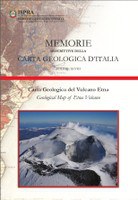Geological Map of Etna volcano
Mount Etna, one of the most active volcanoes in the world, is located at the eastern coast of Sicily in one of the most densely populated areas of the Mediterranean basin. An active volcano, such as Etna, is a potential risk to the residing community because of its possible side-destructive eruptions the estimate and possible prediction of which are largely based on the archive of past eruptions. The surveys and field data, their analysis and related interpretations provide useful information about the frequency, magnitude, distribution and style of volcanic activities that generated the forms and deposits distributed in the volcanic territory. The geological map is an extraordinary archive of data on past eruptions and can be used for practical purposes such as, for example, land management and its prevention from the impact of eruptions in order to minimize the exposure of materials to the damages caused by the eruptions, above all the most catastrophic ones, and be useful also to handle volcanic emergencies. In the last decade the Etna has become one of the best monitored and studied volcanoes in the world and is considered a natural laboratory for volcanologists and geophysicists.
This volume presents the Italian translation of the new geological map of the volcano Etna at 1:50,000, scale published in 2011 by the scientific magazine Italian Journal of Geosciences, accompanied by isotopic dating 40Ar/39Ar of the mapped volcanic units, by the reconstruction of the volcano geological evolution and by the archeomagnetic and 226Ra-230Th dating of historical lavas.
The Memory is organized into chapters written by different Authors with the aim of illustrating the new geological map of the Etna volcano by the description of the data collected and by the used methodologies, highlighting the main developments and innovations shown in this geological map compared to those previously published.
Publication in Italian
Cost of the volume 26,00 € TAX included
- Summary
-
- Geological setting and the substratum of Etna volcano
- Geological maps of Etna volcano along the history
- Methodological approach to the new geological map of Etna volcano
- Explanatory notes of the stratigraphic units belonging to the Mount Etna Volcanic District
- 40Ar/39Ar isotopic dating of Etna volcanic succession
- Geological Evolution of Mount Etna
- The Etna eruptive activity in the last 2700 years
Appendix 2: Stratigraphic logs

